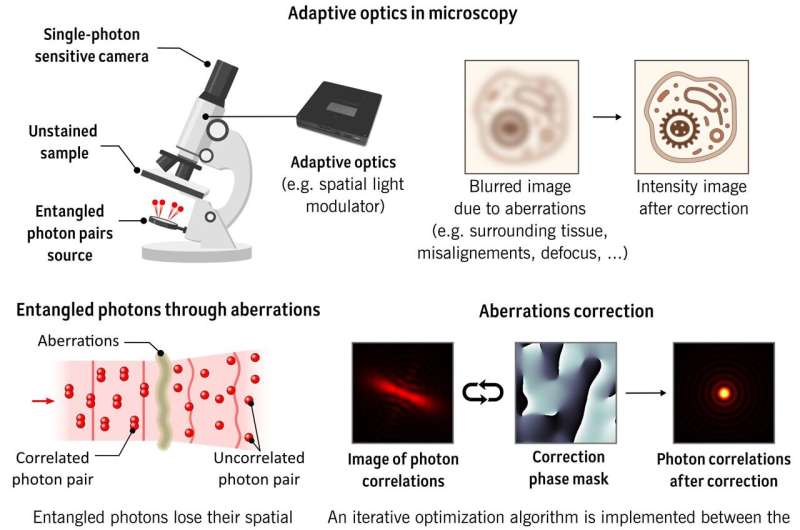This article has been reviewed according to Science X's editorial process and policies. Editors have highlighted the following attributes while ensuring the content's credibility:
fact-checked
trusted source
proofread
Quantum imaging could create bright future for advanced microscopes

The unique properties of quantum physics could help solve a longstanding problem that prevents microscopes from producing sharper images at the smallest scales, researchers say.
The breakthrough, which uses entangled photons to create a new method of correcting for image distortion in microscopes, could lead to improved classical microscope imaging of tissue samples to help advance medical research.
It could also lead to new advances in quantum-enhanced microscopy for use across a wide range of fields. The team's paper, titled "Adaptive Optical Imaging with Entangled Photons," is published in Science. Researchers from the University of Cambridge and the Laboratoire Kastler Brossel in France also contributed to the research.
Microscopes have been invaluable tools for scientists for hundreds of years. Advances in optics have enabled researchers to resolve ever-more detailed images of the fundamental structures of cells and materials.
However, as microscopes have developed in complexity, they have begun to run up against the limits of conventional optical technology, where even tiny flaws in the elements which resolve images can produce blurred images.
Currently, a process called adaptive optics is used to correct image distortions caused by aberrations. Aberrations can be caused by small imperfections in lenses and other optical components or by flaws in the sample under the microscope.
The key to adaptive optics is a "guide star"—a bright spot identified in the sample under the microscope which provides a reference point for detecting aberrations. Devices called spatial light modulators can then shape the light and correct for these distortions.
Reliance on guide stars poses problems for microscopes that image samples like cells and tissues which don't contain bright spots. Scientists have developed guide star-free adaptive optics using image processing algorithms, but these can fail for samples with complex structures.
In the new paper, researchers from the U.K. and France outline how they used entangled photons to sense and correct for aberrations that normally distort microscope images. They call the process quantum-assisted adaptive optics.
The paper describes how they use their new technique to correct for distortion and retrieve high-resolution images of biological test samples—the mouthpiece and leg of a honeybee. They also demonstrate aberration correction for samples with three dimensional structures—a situation where classical adaptive optics often fails.
They used entangled photon pairs to illuminate the samples, allowing them to capture a conventional image and measure the quantum correlations at the same time.
When the entangled photon pairs encounter aberration, their entanglement—in the form of quantum correlations—becomes degraded. The researchers show that the way these quantum correlations are degraded actually reveals information about the aberrations and allows them to be corrected using sophisticated computer analysis.
The information contained in the correlations allows for a precise characterization of aberrations, enabling their correction with a spatial light modulator afterward. The paper shows that the correlations can be used to produce clearer, more high-resolution images than conventional brightfield microscopy techniques.
Patrick Cameron, of the University of Glasgow's School of Physics & Astronomy, is the paper's first author. He said, "Complex samples like biological tissues can be challenging to image using conventional approaches to microscopy, where the bright star technique can fail because there are rarely natural bright spots in human or animal tissue.
"This research shows that quantum-entangled sources of light can be used to probe samples in ways that are much more challenging, if not impossible, with traditional microscopy. Identifying and correcting aberrations and distortions with entangled photons allowed us to produce sharper images without the need for a guide star."
Dr. Hugo Defienne began work on the research at the University of Glasgow's School of Physics & Astronomy before moving to the Paris Institute of Nanosciences at Sorbonne University, where he is now based. Dr. Defienne, last author on the paper, said, "This new technique could be broadly applied to all kinds of conventional optical microscopes to help improve imaging of a wide range of samples. We demonstrated its effectiveness on biological samples, suggesting that it could be used in medical and biology sectors in the future.
"It could also be applied to the emerging field of quantum microscopy, which has tremendous potential to produce images beyond the limits of classical light."
The team still have some technical hurdles to overcome before the technique can be widely adopted in optical microscopes.
Professor Daniele Faccio, who leads the University of Glasgow's Extreme Light research group, is a co-author of the paper. He said, "The next generation of cameras and light sources are likely to help improve the speed which images can be resolved using this technique. We will continue to work on refining and developing the process and look forward to finding new real-world applications for advanced microscopy as we progress."
More information: Patrick Cameron et al, Adaptive optical imaging with entangled photons, Science (2024). DOI: 10.1126/science.adk7825
Provided by University of Glasgow




















